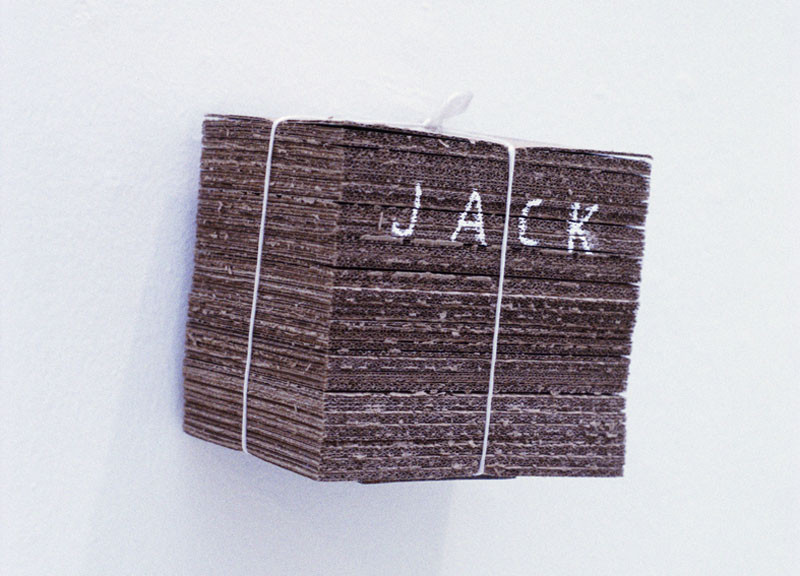Félix Curto
28 Jan - 09 Sep 2012
FÉLIX CURTO
American Junk
Curator: Agustín Pérez Rubio
Coordination: Eneas Bernal
28 January - 9 September, 2012
In Félix Curto's (Salamanca, 1967) artistic career the experiences he gathered throughout the Mexican geography and its various social, cultural, economic and political layers are essential. This American country has been for more than a decade where the artist has been residing for long periods of time, a context where personal taste and interest in an era–that of the American and European counterculture from the 1960s to the present day–ended up combining with his professional work.
The exhibition American Junk takes its name from the eponymous title of Edwin Gilbert 's book American Chrome, a B series novel that reveals the perverse games of the American automobile industry in the 20th century. The title alludes, in turn, to the popular nickname given to many "gringo" objects which, already in disuse in the United States, continue traveling through Latin America. Popular items such as license plates, refrigerators or radios, which are collected by the artist, who subsequently modify them in his workshop to compose objects, installations and sculptures that would have the tribute to authors and references essential in the life of the artist as nexus.
Besides these artifacts, the tour of the exhibition is completed with a wide selection of recent drawings and paintings. All of them bring to light a creative universe that stands out for the synthesis of the materials, the language games, and for showing the work process. Concepts highly visible in the dripping works both in paintings and drawings as well as in the objects that the artist minimally intervene. The poetry of authors such as Allen Ginsberg, Jack Kerouac and Neal Cassady; the encounters with cinematographic works such as Paris-Texas, Easy Rider or Il Sorpasso; and especially the musical cult authors like Chet Baker, Hank Williams, Johnny Cash, or The Box Tops, together with more present musicians ranging from Herman Dune, Mark Olson, The Smiles & Frowns or Sonny Smith to the low-fi music of the band The Magnetic Fields, set out the sensitivity of Curto's work.
These affective references grow in the more than 60 works that comprise the exhibition . Works that manage to stress the spectator, approaching them to intimate landscapes–as it happens in the pieces Dad or I've Loved Her so Long–but also to share the paths and searches of Curto through a territory where it is possible to listen again to the wishes of all those who sought to build "another" world, evidencing the fissures of American culture and the dream of "an American way of life".
The result is an approach to the author's poetic maturity, who shows a landscape crossed by the social, by the border relations linked to oppression or consumption, thanks to some artistic productions which establish other narratives and other cultural references that, ultimately, present life experiences on these by-products of the global economy which surround us and populate the policy of our memory.
American Junk
Curator: Agustín Pérez Rubio
Coordination: Eneas Bernal
28 January - 9 September, 2012
In Félix Curto's (Salamanca, 1967) artistic career the experiences he gathered throughout the Mexican geography and its various social, cultural, economic and political layers are essential. This American country has been for more than a decade where the artist has been residing for long periods of time, a context where personal taste and interest in an era–that of the American and European counterculture from the 1960s to the present day–ended up combining with his professional work.
The exhibition American Junk takes its name from the eponymous title of Edwin Gilbert 's book American Chrome, a B series novel that reveals the perverse games of the American automobile industry in the 20th century. The title alludes, in turn, to the popular nickname given to many "gringo" objects which, already in disuse in the United States, continue traveling through Latin America. Popular items such as license plates, refrigerators or radios, which are collected by the artist, who subsequently modify them in his workshop to compose objects, installations and sculptures that would have the tribute to authors and references essential in the life of the artist as nexus.
Besides these artifacts, the tour of the exhibition is completed with a wide selection of recent drawings and paintings. All of them bring to light a creative universe that stands out for the synthesis of the materials, the language games, and for showing the work process. Concepts highly visible in the dripping works both in paintings and drawings as well as in the objects that the artist minimally intervene. The poetry of authors such as Allen Ginsberg, Jack Kerouac and Neal Cassady; the encounters with cinematographic works such as Paris-Texas, Easy Rider or Il Sorpasso; and especially the musical cult authors like Chet Baker, Hank Williams, Johnny Cash, or The Box Tops, together with more present musicians ranging from Herman Dune, Mark Olson, The Smiles & Frowns or Sonny Smith to the low-fi music of the band The Magnetic Fields, set out the sensitivity of Curto's work.
These affective references grow in the more than 60 works that comprise the exhibition . Works that manage to stress the spectator, approaching them to intimate landscapes–as it happens in the pieces Dad or I've Loved Her so Long–but also to share the paths and searches of Curto through a territory where it is possible to listen again to the wishes of all those who sought to build "another" world, evidencing the fissures of American culture and the dream of "an American way of life".
The result is an approach to the author's poetic maturity, who shows a landscape crossed by the social, by the border relations linked to oppression or consumption, thanks to some artistic productions which establish other narratives and other cultural references that, ultimately, present life experiences on these by-products of the global economy which surround us and populate the policy of our memory.

